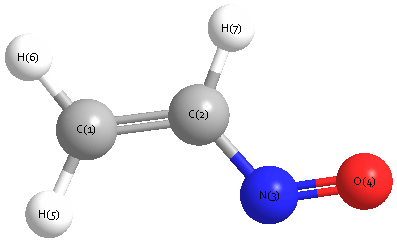Vibrational Frequencies calculated at TPSSh/daug-cc-pVDZ
| Mode Number |
Symmetry |
Frequency
(cm-1) |
Scaled Frequency
(cm-1) |
IR Intensities
(km mol-1) |
Raman Act
(Å4/u) |
Dep P |
Dep U |
|---|
| 1 |
A' |
3260 |
3260 |
1.68 |
65.62 |
0.68 |
0.81 |
| 2 |
A' |
3161 |
3161 |
6.13 |
189.86 |
0.12 |
0.22 |
| 3 |
A' |
3144 |
3144 |
6.02 |
22.49 |
0.61 |
0.76 |
| 4 |
A' |
1665 |
1665 |
1.45 |
40.57 |
0.08 |
0.14 |
| 5 |
A' |
1551 |
1551 |
134.84 |
68.58 |
0.43 |
0.60 |
| 6 |
A' |
1414 |
1414 |
24.73 |
26.10 |
0.36 |
0.53 |
| 7 |
A' |
1278 |
1278 |
2.27 |
8.60 |
0.23 |
0.38 |
| 8 |
A' |
1139 |
1139 |
81.81 |
25.69 |
0.39 |
0.57 |
| 9 |
A' |
888 |
888 |
29.80 |
0.26 |
0.37 |
0.55 |
| 10 |
A' |
601 |
601 |
1.35 |
10.98 |
0.11 |
0.19 |
| 11 |
A' |
336 |
336 |
1.02 |
0.94 |
0.69 |
0.81 |
| 12 |
A" |
1023 |
1023 |
28.45 |
3.13 |
0.75 |
0.86 |
| 13 |
A" |
1002 |
1002 |
24.73 |
0.43 |
0.75 |
0.86 |
| 14 |
A" |
674 |
674 |
0.74 |
0.65 |
0.75 |
0.86 |
| 15 |
A" |
184 |
184 |
0.10 |
0.28 |
0.75 |
0.86 |
Unscaled Zero Point Vibrational Energy (zpe) 10659.6 cm
-1
Scaled (by 1) Zero Point Vibrational Energy (zpe) 10659.6 cm
-1
See section
III.C.1 List or set vibrational scaling factors
to change the scale factors used here.
See section
III.C.2
Calculate a vibrational scaling factor for a given set of molecules
to determine the least squares best scaling factor.
Charges, Dipole, Quadrupole and Polarizability
Charges from optimized geometry at TPSSh/daug-cc-pVDZ
Charges (e)
| Number |
Element |
Mulliken |
CHELPG |
AIM |
ESP |
| 1 |
C |
0.184 |
|
|
|
| 2 |
C |
1.960 |
|
|
|
| 3 |
N |
0.154 |
|
|
|
| 4 |
O |
-0.296 |
|
|
|
| 5 |
H |
-0.633 |
|
|
|
| 6 |
H |
-0.698 |
|
|
|
| 7 |
H |
-0.672 |
|
|
|
Electric dipole moments
Electric dipole components in Debye
(What's a Debye? See section
VII.A.3)
| |
x |
y |
z |
Total |
| |
1.504 |
3.031 |
0.000 |
3.384 |
| CHELPG |
|
|
|
|
| AIM |
|
|
|
|
| ESP |
|
|
|
|
Electric Quadrupole moment
Quadrupole components in D Å
Polarizabilities
Components of the polarizability tensor.
Units are
Å
3 (Angstrom cubed)
Change units.
| |
x |
y |
z |
| x |
7.627 |
2.118 |
0.000 |
| y |
2.118 |
7.375 |
0.000 |
| z |
0.000 |
0.000 |
3.942 |
<r2> (average value of r
2) Å
2
| <r2> |
76.662 |
| (<r2>)1/2 |
8.756 |
